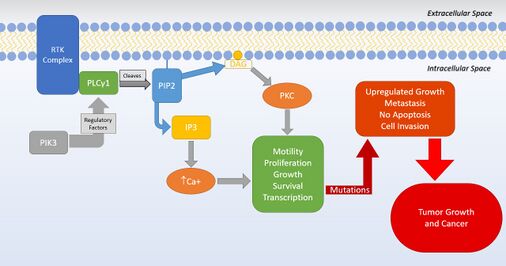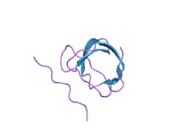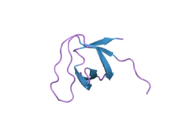Biology:PLCG1
 Generic protein structure example |
Phospholipase C, gamma 1, also known as PLCG1 and PLCgamma1, is a protein that in humans involved in cell growth, migration, apoptosis, and proliferation. It is encoded by the PLCG1 gene[1][2] and is part of the PLC superfamily.
Function
PLCγ1 is a cell growth factor[3][4] from the PLC superfamily. PLCγ1 is used during the cell growth[3] and in a cell migration[5] and apoptosis,[4] all of which are vital cell processes that, if disrupted by mutations, can cause cancerous cells to form within the body. Mutations in this protein show an increase in issues in cells regarding regulation of proliferation and their cell signaling.[3] PLCγ1 roles are also involved in neuronal actin growth, calcium signaling, and brain development.[6][4][5] It is highly regulated by multiple factors, such as PIK3, AMPK, and FAK.[4][7] It is part of the PIP3 pathway and leads to and increase in calcium in the cells. In neuronal cells, PLCγ1 is highly involved in actin cytoskeleton organization and synaptic plasticity.[6] The basic PLCγ1 pathway, as scientists currently understand it, is seen below.
The protein encoded by this gene catalyzes the formation of inositol 1,4,5-trisphosphate (IP3) and diacylglycerol (DAG) from phosphatidylinositol 4,5-bisphosphate. This reaction uses calcium as a cofactor and plays an important role in the intracellular transduction of receptor-mediated tyrosine kinase activators. For example, when activated by SRC, the encoded protein causes the Ras guanine nucleotide exchange factor RASGRP1 to translocate to the Golgi apparatus, where it activates Ras. Also, this protein has been shown to be a major substrate for heparin-binding growth factor 1 (acidic fibroblast growth factor)-activated tyrosine kinase. The receptor protein tyrosine phosphatase PTPmu (PTPRM) is capable of dephosphorylating PLCG1.[8] Two transcript variants encoding different isoforms have been found for this gene.[9]
Common to all PLC isozymes, PLCG1 consists of an N-terminal PH domain, which translocates PLC to the plasma membrane and binds PIP3;[10] four EF hands; an X and Y catalytic region comprising the TIM barrel; and a C-terminal C2 domain.[11] Specific to the PLCG isozymes is a large separation between the X and Y domains consisting of a split PH domain, tandem SH2 domains, and an SH3 domain.[11] The SH2 domains bind phosphorylated tyrosine residues on target proteins via their FLVR sequence motifs, activating the catalytic function of PLCg; and the SH3 domain binds to proline-rich sequences on the target protein.[11]
PLCG1 can be activated by receptor tyrosine kinases (RTKs) and non-receptor tyrosine kinases. For example, when activated, fibroblast growth factor receptor 1 and epidermal growth factor receptor are RTKs that have phosphorylated tyrosines, which provide docking sites for PLCG1 SH2 domains.[11] The activated RTKs phosphoylate PLCG1 at tyrosines located at position 472, 771, 775, 783, and 1254.[12] Non-receptor tyrosine kinases interact with PLCG1 in large complexes at the plasma membrane. For example, in T cells, Lck and Fyn (Src family kinases) phosphorylate immunoreceptor tyrosine-based activation motifs (ITAMs) on the T-cell antigen receptor (TCR).[11] The phosphorylated ITAMs recruit ZAP-70, which phosphorylates tyrosines in LAT and SLP-76. PLCg1 binds to LAT through its n-terminal SH2 domain and to SLP-76 via its SH3 domain.[11]
Has been shown to interact with CISH which negatively regulates it by targeting it for degradation.[13] The deletion of Cish in effector T cells has been shown to augment TCR signaling and subsequent effector cytokine release, proliferation and survival. The adoptive transfer of tumor-specific effector T cells knocked out or knocked down for CISH resulted in a significant increase in functional avidity and long-term tumor immunity. There are no changes in activity or phosphorylation of Cish's purported target, STAT5 in either the presence or absence of Cish.
In vitro studies have shown signs of PLCγ1 having many cell-motility functions, however in vivo have not been able to show a physiological role for PLCγ1.[14] While PLCγ1 is well documented and easily found in the body, clear connections and roles for PLCγ1 have been difficult to find in in vivo studies. Despite this, there is still able to find links between levels of PLCγ1 and cancer patient survivability.
Cancer
While there is a strong link between PLCγ1 and tumor growth/cancer progression, most research is in early stages. Cancer is also a very unique illness in that every patient has different needs. Information here is not to be used as treatment and instead as a way to better understand cancer progression.
Mutations in PLCγ1 can lead to cancer cell proliferations and inhibition can lead to tumor growth.[15] PLCγ1 is involved in cell proliferation, and mutations cause it to be over expressed and help the progression of tumor cells. This aspect of PLCγ1 also helps cancer migration and metastasis away from the original tumor cells.[16][17] There is also a link between PLCγ1 and PDK, the PDK-PLCγ1 pathway, which is a vital part of cancer cell invasion.[17]
The inhibition of PLCγ1 is linked to a decrease in tumor growth and metastasis.[15][16] PLCγ1 is acting as a vital part in stopping apoptosis in cells, and thus by inhibiting PLCγ1 the body better allows programmed cell death and avoidance of tumors.[15][16] The main role found for PLCγ1 is cell growth, and this role in specific is why it is becoming more commonly studied for anti-cancer drugs.[16][17] Tissue samples from cancer patients the PLCγ1 levels are not elevated, however, regulatory factors for this proteins are lowered and that amplification of PLCγ1 is extremely high.[16] The regulatory proteins that stop PLCγ1 have been turned off by the cell, which means that while there is no increase in the physical protein PLCγ1 there is an increase in how much work it is doing - nothing is stopping it from over working itself. Studies also showed that adding new regulatory to cells in vitro helped reduce previously amplified PLCγ1.[15] This information has encouraged PLCγ1 becoming an anti-cancer drug target despite the issues that come with targeting intermembrane proteins.[15][17][18]
Interactions
PLCG1 has been shown to interact with:
- BAG3,[19]
- CD117,[20][21]
- CD31,[22]
- Cbl gene[23][24]
- CISH[13]
- Epidermal growth factor receptor,[23][25]
- Eukaryotic translation elongation factor 1 alpha 1,[26]
- FLT1,[27]
- GAB1,[28][29]
- GIT1,[30]
- Grb2,[31][32][33]
- HER2/neu,[34][35]
- IRS2,[36]
- ITK,[37][38]
- KHDRBS1,[39][40][41]
- Linker of activated T cells,[42][43][44]
- Lymphocyte cytosolic protein 2,[45]
- PDGFRA,[46]
- PLD2,[47]
- RHOA,[48]
- SOS1,[33][49]
- TUB,[50]
- TrkA,[51][52][53][54]
- TrkB,[53][55]
- VAV1,[56] and
- Wiskott-Aldrich syndrome protein.[57][58]
See also
References
- ↑ "Phospholipase C-148: chromosomal location and deletion mapping of functional domains". Cold Spring Harbor Symposia on Quantitative Biology 53 (2): 915–20. 1988. doi:10.1101/sqb.1988.053.01.105. PMID 3254788.
- ↑ "Characterization and cDNA cloning of phospholipase C-gamma, a major substrate for heparin-binding growth factor 1 (acidic fibroblast growth factor)-activated tyrosine kinase". Molecular and Cellular Biology 10 (9): 4770–7. September 1990. doi:10.1128/mcb.10.9.4770. PMID 2167438.
- ↑ 3.0 3.1 3.2 "Dysfunction of phospholipase Cγ in immune disorders and cancer". Trends in Biochemical Sciences 39 (12): 603–11. December 2014. doi:10.1016/j.tibs.2014.09.004. PMID 25456276. http://discovery.ucl.ac.uk/1455633/1/TIBS_Katan_M.pdf.
- ↑ 4.0 4.1 4.2 4.3 "Role of phospholipase C in cell invasion and metastasis". Advances in Biological Regulation 53 (3): 309–18. September 2013. doi:10.1016/j.jbior.2013.07.006. PMID 23925006.
- ↑ 5.0 5.1 "PLCγ1: Potential arbitrator of cancer progression". Advances in Biological Regulation 67: 179–189. January 2018. doi:10.1016/j.jbior.2017.11.003. PMID 29174396.
- ↑ 6.0 6.1 "The function of PLCγ1 in developing mouse mDA system". Advances in Biological Regulation 75: 100654. January 2020. doi:10.1016/j.jbior.2019.100654. PMID 31558431.
- ↑ "in vitro". International Journal of Biological Sciences 16 (8): 1427–1440. 2020. doi:10.7150/ijbs.42962. PMID 32210730. PMC 7085223. http://www.ijbs.com/v16p1427.htm.
- ↑ "Identification of phospholipase C gamma1 as a protein tyrosine phosphatase mu substrate that regulates cell migration". Journal of Cellular Biochemistry 112 (1): 39–48. January 2011. doi:10.1002/jcb.22710. PMID 20506511.
- ↑ "Entrez Gene: PLCG1 phospholipase C, gamma 1". https://www.ncbi.nlm.nih.gov/sites/entrez?Db=gene&Cmd=ShowDetailView&TermToSearch=5335.
- ↑ "Molecular modeling of the membrane targeting of phospholipase C pleckstrin homology domains". Protein Science 12 (9): 1934–53. September 2003. doi:10.1110/ps.0358803. PMID 12930993.
- ↑ 11.0 11.1 11.2 11.3 11.4 11.5 "The phospholipase C isozymes and their regulation". Phosphoinositides I: Enzymes of Synthesis and Degradation. Subcellular Biochemistry. 58. March 2012. pp. 61–94. doi:10.1007/978-94-007-3012-0_3. ISBN 978-94-007-3011-3.
- ↑ "The selectivity of receptor tyrosine kinase signaling is controlled by a secondary SH2 domain binding site". Cell 138 (3): 514–24. August 2009. doi:10.1016/j.cell.2009.05.028. PMID 19665973.
- ↑ 13.0 13.1 "Cish actively silences TCR signaling in CD8+ T cells to maintain tumor tolerance". The Journal of Experimental Medicine 212 (12): 2095–113. November 2015. doi:10.1084/jem.20150304. PMID 26527801.
- ↑ "The function of PLCγ1 in developing mouse mDA system". Advances in Biological Regulation 75: 100654. January 2020. doi:10.1016/j.jbior.2019.100654. PMID 31558431.
- ↑ 15.0 15.1 15.2 15.3 15.4 "in vitro". International Journal of Biological Sciences 16 (8): 1427–1440. 2020. doi:10.7150/ijbs.42962. PMID 32210730. PMC 7085223. http://www.ijbs.com/v16p1427.htm.
- ↑ 16.0 16.1 16.2 16.3 16.4 "PLCγ1: Potential arbitrator of cancer progression". Advances in Biological Regulation 67: 179–189. January 2018. doi:10.1016/j.jbior.2017.11.003. PMID 29174396.
- ↑ 17.0 17.1 17.2 17.3 "Role of phospholipase C in cell invasion and metastasis". Advances in Biological Regulation 53 (3): 309–18. September 2013. doi:10.1016/j.jbior.2013.07.006. PMID 23925006.
- ↑ "Dysfunction of phospholipase Cγ in immune disorders and cancer". Trends in Biochemical Sciences 39 (12): 603–11. December 2014. doi:10.1016/j.tibs.2014.09.004. PMID 25456276. http://discovery.ucl.ac.uk/1455633/1/TIBS_Katan_M.pdf.
- ↑ "CAIR-1/BAG-3 forms an EGF-regulated ternary complex with phospholipase C-gamma and Hsp70/Hsc70". Oncogene 19 (38): 4385–95. September 2000. doi:10.1038/sj.onc.1203797. PMID 10980614.
- ↑ "Stem cell factor induces phosphatidylinositol 3'-kinase-dependent Lyn/Tec/Dok-1 complex formation in hematopoietic cells". Blood 96 (10): 3406–13. November 2000. doi:10.1182/blood.V96.10.3406. PMID 11071635. https://pure.eur.nl/en/publications/395fb5fc-60e3-45d7-a9b1-fc7b9cc6b4bc.
- ↑ "The MATK tyrosine kinase interacts in a specific and SH2-dependent manner with c-Kit". The Journal of Biological Chemistry 270 (16): 9661–6. April 1995. doi:10.1074/jbc.270.16.9661. PMID 7536744.
- ↑ "Differential association of cytoplasmic signalling molecules SHP-1, SHP-2, SHIP and phospholipase C-gamma1 with PECAM-1/CD31". FEBS Letters 450 (1–2): 77–83. April 1999. doi:10.1016/s0014-5793(99)00446-9. PMID 10350061.
- ↑ 23.0 23.1 "EGF-dependent association of phospholipase C-gamma1 with c-Cbl". Experimental Cell Research 277 (1): 86–94. July 2002. doi:10.1006/excr.2002.5545. PMID 12061819.
- ↑ "Sequences surrounding the Src-homology 3 domain of phospholipase Cgamma-1 increase the domain's association with Cbl". Biochemical and Biophysical Research Communications 249 (2): 537–41. August 1998. doi:10.1006/bbrc.1998.9177. PMID 9712732.
- ↑ "Cytoskeletal association of epidermal growth factor receptor and associated signaling proteins is regulated by cell density in IEC-6 intestinal cells". Journal of Cellular Physiology 172 (1): 126–36. July 1997. doi:10.1002/(SICI)1097-4652(199707)172:1<126::AID-JCP14>3.0.CO;2-A. PMID 9207933.
- ↑ "Interaction of elongation factor-1alpha and pleckstrin homology domain of phospholipase C-gamma 1 with activating its activity". The Journal of Biological Chemistry 277 (22): 19697–702. May 2002. doi:10.1074/jbc.M111206200. PMID 11886851.
- ↑ "Interactions of FLT-1 and KDR with phospholipase C gamma: identification of the phosphotyrosine binding sites". Biochemical and Biophysical Research Communications 240 (3): 635–9. November 1997. doi:10.1006/bbrc.1997.7719. PMID 9398617.
- ↑ "Potential role of Gab1 and phospholipase C-gamma in osmotic shock-induced glucose uptake in 3T3-L1 adipocytes". Hormone and Metabolic Research 33 (7): 402–6. July 2001. doi:10.1055/s-2001-16227. PMID 11507676.
- ↑ "A Grb2-associated docking protein in EGF- and insulin-receptor signalling". Nature 379 (6565): 560–4. February 1996. doi:10.1038/379560a0. PMID 8596638. Bibcode: 1996Natur.379..560H.
- ↑ "GIT1 mediates Src-dependent activation of phospholipase Cgamma by angiotensin II and epidermal growth factor". The Journal of Biological Chemistry 278 (50): 49936–44. December 2003. doi:10.1074/jbc.M307317200. PMID 14523024.
- ↑ "A new function for phospholipase C-gamma1: coupling to the adaptor protein GRB2". Archives of Biochemistry and Biophysics 345 (1): 103–10. September 1997. doi:10.1006/abbi.1997.0245. PMID 9281317.
- ↑ "Ligation of the T-cell antigen receptor (TCR) induces association of hSos1, ZAP-70, phospholipase C-gamma 1, and other phosphoproteins with Grb2 and the zeta-chain of the TCR". The Journal of Biological Chemistry 270 (31): 18428–36. August 1995. doi:10.1074/jbc.270.31.18428. PMID 7629168.
- ↑ 33.0 33.1 "Engagement of the T lymphocyte antigen receptor regulates association of son-of-sevenless homologues with the SH3 domain of phospholipase Cgamma1". European Journal of Immunology 30 (8): 2378–87. August 2000. doi:10.1002/1521-4141(2000)30:8<2378::AID-IMMU2378>3.0.CO;2-E. PMID 10940929.
- ↑ "Oncogenic forms of the neu/HER2 tyrosine kinase are permanently coupled to phospholipase C gamma". The EMBO Journal 10 (8): 2077–86. August 1991. doi:10.1002/j.1460-2075.1991.tb07739.x. PMID 1676673.
- ↑ "Elevated content of the tyrosine kinase substrate phospholipase C-gamma 1 in primary human breast carcinomas". Proceedings of the National Academy of Sciences of the United States of America 88 (23): 10435–9. December 1991. doi:10.1073/pnas.88.23.10435. PMID 1683701. Bibcode: 1991PNAS...8810435A.
- ↑ "IL-13 induces tyrosine phosphorylation of phospholipase C gamma-1 following IRS-2 association in human monocytes: relationship with the inhibitory effect of IL-13 on ROI production". Biochemical and Biophysical Research Communications 244 (3): 665–70. March 1998. doi:10.1006/bbrc.1998.8314. PMID 9535722.
- ↑ "Regulated association between the tyrosine kinase Emt/Itk/Tsk and phospholipase-C gamma 1 in human T lymphocytes". Journal of Immunology 163 (12): 6435–41. December 1999. doi:10.4049/jimmunol.163.12.6435. PMID 10586033.
- ↑ "The proline rich region of the Tec homology domain of ITK regulates its activity". FEBS Letters 525 (1–3): 53–8. August 2002. doi:10.1016/s0014-5793(02)03066-1. PMID 12163161.
- ↑ "UCS15A, a novel small molecule, SH3 domain-mediated protein-protein interaction blocking drug". Oncogene 21 (13): 2037–50. March 2002. doi:10.1038/sj.onc.1205271. PMID 11960376.
- ↑ "Sam68 association with p120GAP in CD4+ T cells is dependent on CD4 molecule expression". Journal of Immunology 161 (6): 2798–803. September 1998. doi:10.4049/jimmunol.161.6.2798. PMID 9743338.
- ↑ "Evidence for SH3 domain directed binding and phosphorylation of Sam68 by Src". Oncogene 18 (33): 4647–53. August 1999. doi:10.1038/sj.onc.1203079. PMID 10467411.
- ↑ "LAT palmitoylation: its essential role in membrane microdomain targeting and tyrosine phosphorylation during T cell activation". Immunity 9 (2): 239–46. August 1998. doi:10.1016/s1074-7613(00)80606-8. PMID 9729044.
- ↑ "Mapping the Zap-70 phosphorylation sites on LAT (linker for activation of T cells) required for recruitment and activation of signalling proteins in T cells". The Biochemical Journal 356 (Pt 2): 461–71. June 2001. doi:10.1042/0264-6021:3560461. PMID 11368773.
- ↑ "LAT: the ZAP-70 tyrosine kinase substrate that links T cell receptor to cellular activation". Cell 92 (1): 83–92. January 1998. doi:10.1016/S0092-8674(00)80901-0. PMID 9489702.
- ↑ "Identification of a phospholipase C-gamma1 (PLC-gamma1) SH3 domain-binding site in SLP-76 required for T-cell receptor-mediated activation of PLC-gamma1 and NFAT". Molecular and Cellular Biology 21 (13): 4208–18. July 2001. doi:10.1128/MCB.21.13.4208-4218.2001. PMID 11390650.
- ↑ "Demonstration of functionally different interactions between phospholipase C-gamma and the two types of platelet-derived growth factor receptors". The Journal of Biological Chemistry 270 (13): 7773–81. March 1995. doi:10.1074/jbc.270.13.7773. PMID 7535778.
- ↑ "The direct interaction of phospholipase C-gamma 1 with phospholipase D2 is important for epidermal growth factor signaling". The Journal of Biological Chemistry 278 (20): 18184–90. May 2003. doi:10.1074/jbc.M208438200. PMID 12646582.
- ↑ "Leukotriene D4 induces association of active RhoA with phospholipase C-gamma1 in intestinal epithelial cells". The Biochemical Journal 365 (Pt 1): 157–63. July 2002. doi:10.1042/BJ20020248. PMID 12071848.
- ↑ "Direct interaction of SOS1 Ras exchange protein with the SH3 domain of phospholipase C-gamma1". Biochemistry 39 (29): 8674–82. July 2000. doi:10.1021/bi992558t. PMID 10913276.
- ↑ "Tyrosine phosphorylation of tub and its association with Src homology 2 domain-containing proteins implicate tub in intracellular signaling by insulin". The Journal of Biological Chemistry 274 (35): 24980–6. August 1999. doi:10.1074/jbc.274.35.24980. PMID 10455176.
- ↑ "Nerve growth factor binds to the 140 kd trk proto-oncogene product and stimulates its association with the src homology domain of phospholipase C gamma 1". Biochemical and Biophysical Research Communications 179 (1): 217–23. August 1991. doi:10.1016/0006-291x(91)91357-i. PMID 1715690. https://deepblue.lib.umich.edu/bitstream/2027.42/29169/1/0000215.pdf.
- ↑ "Identification and characterization of novel substrates of Trk receptors in developing neurons". Neuron 21 (5): 1017–29. November 1998. doi:10.1016/s0896-6273(00)80620-0. PMID 9856458.
- ↑ 53.0 53.1 "The signaling adapter FRS-2 competes with Shc for binding to the nerve growth factor receptor TrkA. A model for discriminating proliferation and differentiation". The Journal of Biological Chemistry 274 (14): 9861–70. April 1999. doi:10.1074/jbc.274.14.9861. PMID 10092678.
- ↑ "Direct interaction of nerve growth factor receptor, TrkA, with non-receptor tyrosine kinase, c-Abl, through the activation loop". FEBS Letters 469 (1): 72–6. March 2000. doi:10.1016/s0014-5793(00)01242-4. PMID 10708759.
- ↑ "Brain-derived neurotrophic factor promotes interaction of the Nck2 adaptor protein with the TrkB tyrosine kinase receptor". Biochemical and Biophysical Research Communications 294 (5): 1087–92. June 2002. doi:10.1016/S0006-291X(02)00606-X. PMID 12074588.
- ↑ "Nuclear association of tyrosine-phosphorylated Vav to phospholipase C-gamma1 and phosphoinositide 3-kinase during granulocytic differentiation of HL-60 cells". FEBS Letters 441 (3): 480–4. December 1998. doi:10.1016/s0014-5793(98)01593-2. PMID 9891995.
- ↑ "Wiskott-Aldrich syndrome protein (WASp) is a binding partner for c-Src family protein-tyrosine kinases". Current Biology 6 (8): 981–8. August 1996. doi:10.1016/s0960-9822(02)00642-5. PMID 8805332.
- ↑ "Identification of regions of the Wiskott-Aldrich syndrome protein responsible for association with selected Src homology 3 domains". The Journal of Biological Chemistry 271 (42): 26291–5. October 1996. doi:10.1074/jbc.271.42.26291. PMID 8824280.
 |










